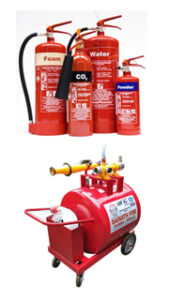HELIPORT FIRE FIGHTING SYSTEM / EQUIPMENT

The level of fire protection required is based on the classification of the heliport. Fire protection for land-based heliports is derived from the largest helicopter that will use the facility. Heliports have been divided into three classifications based on the size of the largest helicopters that the facility will accommodate. The National Fire Protection Association (NFPA) has developed and adopted NFPA 418, Standard for Heliports to provide a guideline for minimum safety standards. Heliports can be land based, on marine vessels and on offshore drilling rigs and platforms. The requirements for marine vessels and offshore drill rigs are determined by USCG and ABS rules and differ slightly from the requirements for land based.
HELIPORT CLASSIFICATIONS
H-1: Helicopter overall length up to but not including 50 ft (15.2 m), with a practical critical fire area of 375 sq. ft. (34.8 sqm.)
H-2: Helicopter overall length from 50 ft (15.2m) up to but not including 80 ft (24.4 m) with a practical critical fire area of 840 sq. ft. (78.0 sqm.)
H-3: Helicopter overall length from 80 ft (24.4) up to but not including 120 ft (36.6) with a practical critical fire area of 1,440 sq. ft. (133.8sqm.)
FOAM FIRE PROTECTION SYSTEMS
NFPA 418 requires a low expansion foam fire fighting system be installed for all roof top heli-ports. In addition to extinguishment of fires, the foam system can be used to prevent the ignition of fuel spills by covering the spill with a foam blanket. NFPA recognizes two types of protection for heliports.
- The first is foam hose lines, which can be either portable, using an eductor and nozzle or pick-up nozzle with hose and a supply of foam concentrate in pails all stored in a cabinet. It may also be a permanently installed proportioning system piped to fixed hose reels or racks.
- The second method is a fixed proportioning system permanently piped to monitors or fixed spray nozzles strategically located around the periphery of the landing pad.
Exception:
(1) Heliports on parking garages, unoccupied buildings or other similar unoccupied structures do not require the installation of a low expansion foam system.
(2) For H-1 heliports, two portable foam fire extinguishers each having a rating of 20-A-160-B shall be permitted to satisfy the requirement.
In addition to the foam system, portable (trolley type) fire extinguishers (CO2 and Dry Powder) are also required. A minimum of two means of access to the landing pad shall be provided for fire-fighters.
